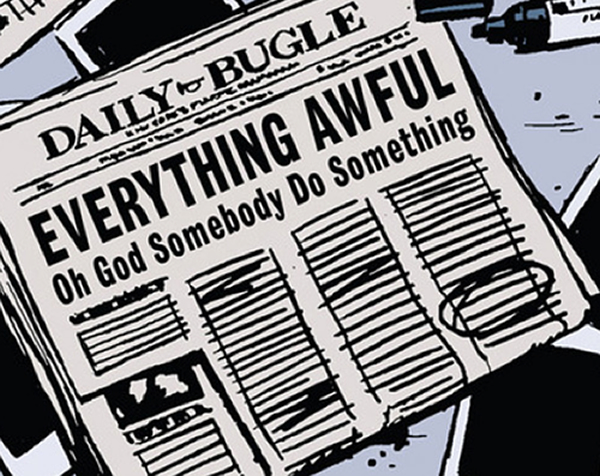Republished by Blog Post Promoter
REMEMBER THE INNOCENT VICTIMS OF FALSE FLAGS ON 9-11
Republished by Blog Post Promoter
Republished by Blog Post Promoter

“MURDER! RAPE! BLOOD! WAR!
delivered daily to your door!
DEATH and MAYHEM! FILM AT 4:00!“
The News will keep you well informed!
Good news is never fit to print;
Bad News Headlines make a mint!
The Press make sure you’ll get upset
each time you watch your TV set.
“IT ISN’T SAFE TO WALK THE STREETS“
“STAY AT HOME BENEATH YOUR SHEETS!”
“CRIMINALS LURK ANYWHERE YOU LOOK!”
It must be true…. it was printed in a book!
“WE NEED MORE GUNS AND THOUGHT POLICE“.
“THE WORLD WILL NEVER BE AT PEACE“.
“DRUGS AND CRIME ARE EVERYWHERE“.
The Press makes sure that we’re “aware”….
Shocking love-life exposes!
Who will they prosecute today?
“THE PUBLIC HAS THE RIGHT TO TRUTH”.
The Press will judge and execute!
Is Free Speech an equal right?
Only for those with financial might
to pay the advertising fees.
The Press is told who to appease.
Lies and rumors, the “news” abounds –
they’ll make it up when there’s none around.
“The truth be damned! I’m a reporter…
It’s my job to cause disorder”!
Like l0bsters in a bubbling pot
who claw and pull to reach the top –
free from miserable despair,
The Press is boiling you in fear!
Every day we all begin
a bright new hopeful day.
Life’s a game we all can win.
It’s lots of fun to play.
Wake up! Don’ get sucked in!
Reporters wearing pearly grins
tell you that life’s all bad;
The Press are all completely mad!
Turn off your TV! Enjoy your day.
In spite of what “the experts” say,
there is no need to be afraid.
Live and Love another day!
______________
A poem by Lawrence R. Spencer. 2013
Republished by Blog Post Promoter
This is a review of the past 1,000 years of changes in the national borders in Europe as a result of the criminals and psychopaths who create warfare, political and economic chaos. This created chaos also causes floods of refugees, fleeing war, rape, plunder and devastation. Lands are invaded, new conflicts are caused and the lives of the innocent are ruthlessly and repeatedly ruined.
Republished by Blog Post Promoter
Propaganda TechniquesEdward Filene helped establish the Institute of Propaganda Analysis in 1937 to educate the American public about the nature of propaganda and how to recognize propaganda techniques. Filene and his colleagues identified the seven most common “tricks of the trade” used by successful propagandists. These seven techniques are called:
These techniques are designed to fool us because the appeal to our emotions rather than to our reason.The techniques identified by the Institute for Propaganda Analysis are further refined by Aaron Delwich in his website, Propaganda where he “discusses various propaganda techniques, provides contemporary examples of their use, and proposes strategies of mental self-defense.” By pointing out these techniques, we hope to join with others who have written on this topic to create awareness and encourage serious consideration of the influence of contemporary propaganda directed at us through the various media and suggest ways to guard against its influence on our lives. Name Calling: Propagandists use this technique to create fear and arouse prejudice by using negative words (bad names) to create an unfavorable opinion or hatred against a group, beliefs, ideas or institutions they would have us denounce. This method calls for a conclusion without examining the evidence. Name Calling is used as a substitute for arguing the merits of an idea, belief, or proposal. It is often employed using sarcasm and ridicule in political cartoons and writing. Testimonial: Propagandists use this technique to associate a respected person or someone with experience to endorse a product or cause by giving it their stamp of approval hoping that the intended audience will follow their example. The Institute for Propaganda Analysis suggests we ask ourselves the following question when confronted with this technique. Who is quoted in the testimonial? Why should we regard this person as an expert or trust their testimony? Is there merit to the idea or product without the testimony? You can guard yourself against this technique by demonstrating that the person giving the testimonial is not a recognized authority, prove they have an agenda or vested interest, or show there is disagreement by other experts. Plain Folks: Propagandists use this approach to convince the audience that the spokesperson is from humble origins, someone they can trust and who has their interests at heart. Propagandists have the speaker use ordinary language and mannerisms to reach the audience and identify with their point of view. (Read the entire article about the history and use of Propaganda) |